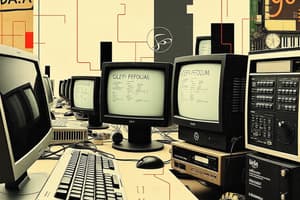Podcast
Questions and Answers
What is the main function of the CPU in a computer?
What is the main function of the CPU in a computer?
- To execute instructions and process data (correct)
- To manage user accounts
- To store data permanently
- To connect to the internet
Which of the following is NOT a type of software?
Which of the following is NOT a type of software?
- Application Software
- Utility Software
- Operating System
- Peripheral device (correct)
What is the primary role of productivity software?
What is the primary role of productivity software?
- To perform tasks for end-users like document creation (correct)
- To manage computer hardware
- To protect the computer from viruses
- To facilitate internet browsing
Which type of network covers a large geographical area?
Which type of network covers a large geographical area?
How can software updates be described?
How can software updates be described?
Which of the following is an example of multimedia software?
Which of the following is an example of multimedia software?
What is NOT included in the basic operations of a computer?
What is NOT included in the basic operations of a computer?
Which of the following file formats is commonly used for spreadsheets?
Which of the following file formats is commonly used for spreadsheets?
What describes the function of servers in a network?
What describes the function of servers in a network?
What is an essential reason for backing up data regularly?
What is an essential reason for backing up data regularly?
Flashcards are hidden until you start studying
Study Notes
Computer Basics
-
Definition of a Computer: An electronic device that processes data, performing tasks according to a set of instructions (software).
-
Components:
- Hardware: Physical components (e.g., CPU, RAM, hard drive, motherboard, peripherals).
- Software: Programs and applications that run on hardware.
-
Types of Computers:
- Personal Computers (PCs): Designed for individual use; includes desktops and laptops.
- Servers: Provide services to other computers over a network.
- Tablets and Smartphones: Mobile computing devices.
-
Basic Operations:
- Input: Data entry via devices like keyboards, mice, and scanners.
- Processing: CPU interprets and executes instructions.
- Output: Results displayed on monitors, printed, or sent elsewhere.
- Storage: Saving data on hard drives, SSDs, or external devices.
PC Software
-
Operating System (OS):
- Software that manages hardware and software resources.
- Common OS: Windows, macOS, Linux.
-
Application Software:
- Programs designed for end-users.
- Categories include:
- Productivity Software: Word processors (e.g., Microsoft Word), spreadsheets (e.g., Excel).
- Web Browsers: Software to access the internet (e.g., Chrome, Firefox).
- Multimedia Software: For editing images, videos, and audio (e.g., Adobe Photoshop, iMovie).
- Games: Software designed for entertainment.
-
Utility Software:
- Tools that help manage, maintain, and control computer resources.
- Examples: Antivirus programs, disk cleanup tools, backup software.
-
Software Installation:
- Downloading or inserting physical media to set up software.
- Licensing: Understanding terms (e.g., free, shareware, commercial).
-
Updates and Maintenance:
- Keeping software current for security and functionality.
- Importance of backing up data regularly.
-
File Management:
- Organizing files and folders for easy access.
- Common file formats: .docx, .xlsx, .jpg, .mp4.
-
Internet and Networking:
- Basics of connecting to the internet and using browsers.
- Understanding networks: LAN (Local Area Network) vs. WAN (Wide Area Network).
Computer Basics
- A computer is an electronic device that processes data based on a set of instructions or software.
- Components:
- Hardware includes physical parts such as CPU, RAM, hard drives, motherboards, and peripherals.
- Software consists of programs and applications that operate on the hardware.
- Types of Computers:
- Personal Computers (PCs) are intended for individual use, including desktops and laptops.
- Servers are specialized computers that provide services and manage resources for other computers on a network.
- Tablets and Smartphones are portable devices facilitating mobile computing.
- Basic Operations:
- Input involves entering data via devices such as keyboards, mice, and scanners.
- Processing refers to the CPU interpreting and executing commands.
- Output entails displaying results on monitors, printing, or transferring data elsewhere.
- Storage involves saving information on hard drives, solid-state drives (SSDs), or external media.
PC Software
- Operating System (OS):
- The OS is essential software that manages both hardware and software resources.
- Popular operating systems include Windows, macOS, and Linux.
- Application Software:
- Designed specifically for end-users and divided into various categories.
- Productivity Software includes word processors like Microsoft Word and spreadsheets such as Excel.
- Web Browsers enable internet access, with common examples being Chrome and Firefox.
- Multimedia Software is utilized for editing content like images and videos, examples include Adobe Photoshop and iMovie.
- Games refer to software developed for entertainment purposes.
- Utility Software:
- These tools aid in managing and maintaining computer resources, including antivirus and disk cleanup tools.
- Software Installation:
- Involves downloading or using physical media to set up applications on a computer.
- Licensing includes understanding various terms such as free, shareware, or commercial software.
- Updates and Maintenance:
- Regular updates are crucial for enhancing security and ensuring proper functionality of software.
- Backing up data is vital to safeguard against data loss.
- File Management:
- Involves organizing files and folders for efficient retrieval and accessibility.
- Common file formats include .docx for documents, .xlsx for spreadsheets, .jpg for images, and .mp4 for videos.
- Internet and Networking:
- Basics include connecting to the internet and utilizing web browsers effectively.
- Understanding networks is key, distinguishing between LAN (Local Area Network) and WAN (Wide Area Network) configurations.
Studying That Suits You
Use AI to generate personalized quizzes and flashcards to suit your learning preferences.




